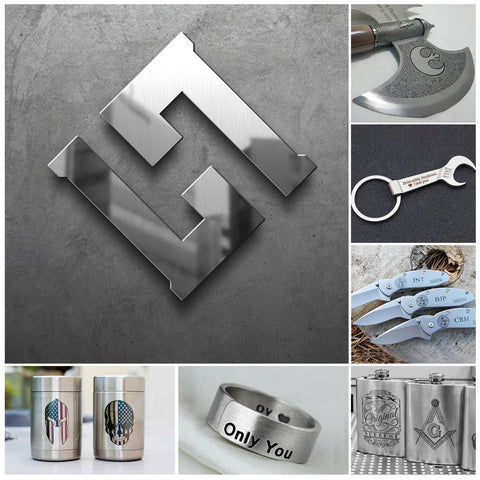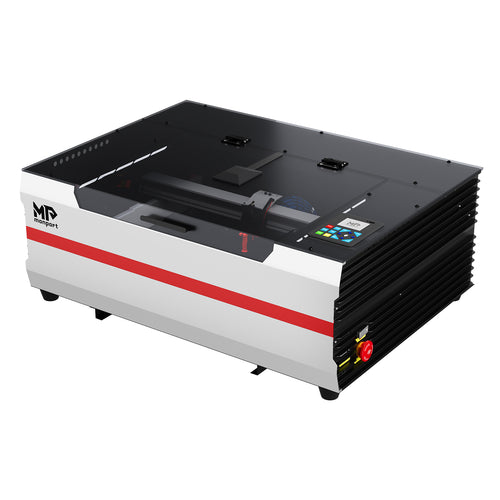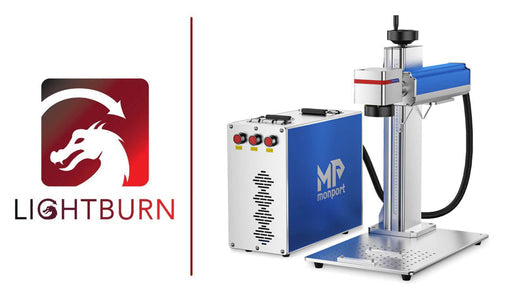As a common engraving material, stainless steel marking can be found in a variety of industries including home furnishings, jewelry, and many others. A stainless steel engraver marking machine can be used to engrave or mark stainless steel for different applications.If you own a small metal laser engraving business, this article will provide you with more engraving and marking technology as well as how to engrave stainless steel. Learn the best method for laser engraving stainless steel with Monport GA MOPA fiber laser engraver.
Monport GA 60W Upgraded Integrated MOPA Fiber Laser Engraver & Marking Machine with Auto Focus
Read More : Master Metal Engraving with the Best Budget Laser Engravers
Choose the Best Laser Engraving Machine
Without a doubt, the fiber laser engraving machine, which is more effective than CO₂ lasers, is the best option for how to engrave stainless steel. This is now widely accepted as the top method for achieving durable and detailed metal marking. The Monport fiber laser uses doped fiber to produce a wavelength of around 1.06 microns, ideal for marking metals like stainless steel, aluminum, and brass with deep, crisp detail.
While CO₂ lasers typically cater to nonmetals, you can still engrave stainless steel by using a laser engraving stainless steel spray, such as CerMark or LaserBond. These sprays pre-treat the surface, allowing CO₂ lasers to mark stainless steel effectively. However, for professional use and deeper marks, fiber stainless steel engravers remain the top choice.
How to Engrave Stainless Steel
Stainless steel is a popular material for laser marking due to its durability and resistance to corrosion. However, laser engraving can be challenging because of its reflective surface, which can damage the laser. Here are proven techniques, including the use of laser engraving stainless steel spray, to achieve clean, professional results:
Use vector images
Vector images are made up of mathematical equations and can be scaled to any size without losing quality. This makes them ideal for cutting or etching lines into stainless steel. It's best to use vector images in formats like .AI, .EPS, .SVG.
Choose the right font
Because stainless steel is a hard, durable material, it's important to choose a font that has thick lines and a bold appearance. This will make the engraving more visible and easier to read.
The best font for engraving for laser engraved stainless steel using a fiber laser engraver is a sans-serif font with clean lines, such as Arial or Helvetica, because they provide clear and legible text that is easily readable. Other good options include Calibri and Verdana.
When selecting a font, it's important to consider factors such as the size and thickness of the letters, as well as the overall contrast between the font and the background material.
Masking
This process is applied when you don't want the laser beam to touch certain areas of the stainless steel. A special tape or coating is applied to the area that needs to be masked, and this will protect them from the laser beam during the engraving process, ensuring precise and controlled laser engraved stainless steel results.
There is no need for pretreatment on laser engraved stainless steel. You can make visible marks on the surface, but you'll need to use a special compound to make deeper marks. It is commonly referred to as metal marking spray. Spray a thin, even layer of paint on the metal. The laser beam then reacts with this compound, leaving a more visible dark mark, which enhances the stainless steel marking process.
Use high contrast colors
Stainless steel is a shiny and reflective surface, so it's important to use high contrast colors to make the engraving stand out. Avoid using colors that are similar to the color of the laser engraved stainless steel, as they will not be visible.
Clean the surface
It is important to clean the stainless steel surface before engraving to remove any dirt, oil, or other contaminants that may affect the engraving quality.
Anodized Coating
Applying an anodized coating to the stainless steel before engraving will also help to reduce reflectivity and increase the contrast of the engraved design. Anodizing is a process where a thin oxide layer is formed on the surface of the stainless steel; this helps to protect the steel and also makes it more receptive to the laser beam, improving the stainless steel marking process for clearer, more vibrant laser engraved stainless steel results.
Using the right laser wavelength
Generally, a 20W fiber laser can easily finish the marking of stainless steel at one time. Some laser wavelength are better absorbed by stainless steel than others. Using a wavelength that is absorbed more readily by the steel can increase the efficiency of the engraving process.
Applications

Stainless steel is widely used and can be used in many applications. When used with a laser marking machine for marking and engraving stainless steel, you can significantly expand your product line and processing capacity. Some common applications of laser engraving and marking stainless steel and other metals include:
- Personalized jewelry, such as pendants, bracelets, and rings.

- Memorial plaques, such as for dedications or memorials.

- Custom signage, such as for business logos or directional signs.

- Gift items, such as photo frames, keychains, and money clips.

- Housewares, such as coasters, wine stoppers, and picture frames.

- Corporate gifts, such as pens, lighters, and desk accessories.

FAQs
-
What materials can Monport laser machines handle?
Monport lasers work on wood, acrylic, metal, leather, glass, and more—ideal for versatile engraving and cutting. -
What are the benefits of Monport CO₂ laser engravers?
They offer high precision, large work areas, and powerful cutting ability, perfect for creators and small businesses. -
Why choose a Monport fiber laser?
Monport fiber lasers are built for speed and accuracy, making them excellent for metal engraving and industrial use. -
Are Monport machines beginner-friendly?
Yes, many models come pre-assembled or semi-assembled, with intuitive controls and tutorials for easy setup. -
What makes Monport stand out from competitors?
Monport offers affordable pricing, solid build quality, and great software compatibility—ideal for hobbyists and pros alike.
Final Thoughts
Whether you're running a small business or scaling up, investing in the right laser engraved stainless steel like the Monport GA 60W MOPA Fiber Laser is key to unlocking professional-grade results. Fiber laser engravers offer the cleanest, most efficient, and most detailed markings on stainless steel. Always remember to test your settings and adjust based on material type, thickness, and final application.
Celebrate Business Week with Monport! Enjoy up to 30% OFF on our premium laser engraving machines and unlock incredible free gifts to elevate your projects. Buy a CO₂ laser and receive a FREE Water Chiller, Rotary Axis, and LightBurn software. Purchase a Fiber Laser and get a FREE Rotary Axis. Plus, score a special $130 OFF on bundle deals and 30% OFF laser engraving materials. Don’t wait — use code BESTMP10 at checkout and click here to shop now!









